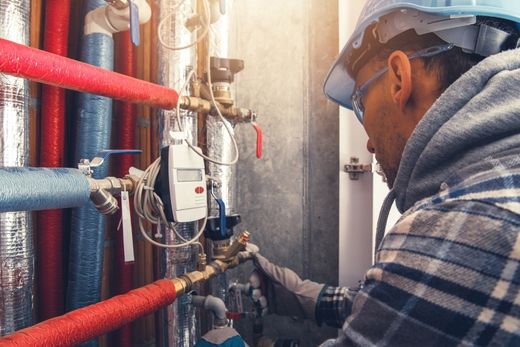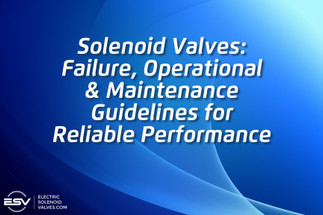Jan 13th 2023
Solenoid Valves: Failure, Operational & Maintenance Guidelines for Reliable Performance
Solenoid valves are electromechanically operated valves used to open or close an opening within an application to allow or prevent media to flow. They consist of a solenoid coil atop a valve body, which includes springs, a plunger and diaphragm.
Electric current flowing through a copper wire wrapped around a tube magnetizes the coil, which causes the plunger to either lift (for normally closed valves) or press down (for normally open valves). This action opens or closes the flow of media, depending on the type of solenoid valve. When the power supply is turned off, the plunger resets and the valve stops or resumes the flow, depending on the type of valve.
These small components are reliable and durable workhorses when specified and maintained correctly.
Solenoid valves are regularly paired with IoT controllers, air accumulators, timers, switches, and other mechanical components such as hydraulic presses and pumps to control a system's predictable and recurring operations effectively. In many applications, air or water is the fluid circulated through solenoid valves, solenoid valves require clean media so fluids with debris or pulp may be better suited for electrically actuated ball valves.. Thanks to their electromechanical design, solenoid valves are also ideal for emergency shut-off systems.
Solenoid valves are fundamentally different from conventional control valves, which may lead to confusion about how they work and the appropriate maintenance methods. It is important to understand their functions to ensure optimal performance. This article will explain what solenoid valves are, how they should be operated, maintained, and in the case of failure, what are the troubleshooting procedures, and to decide whether to repair or replace them.
Solenoid Valves - Why are they critical for the industry?

Although SVs are relatively simple and inexpensive, they can be controlled remotely, making them ideal for various applications compared to conventional valves. SVs are predominantly used in automated processes, hard-to-reach areas (such as underground oil pipelines), and hazardous applications. They can also be used to control a flow of very precise amounts of fluid, making them ideal for use in laboratory and medical applications. Following are five reasons why SVs are critical for any industry:
- Eliminates redundant process sensors
- Allows for remote monitoring and control
- Automate Maintenance, Repair, and Troubleshooting
- Ease of Re-programming and flexible operations
- Connectivity and Universal Integration
- Integrated Power Supply and Energy Efficient Actuation
Operational faults and Failure Modes of Solenoid Valves:
There are many potential causes of Solenoid Valve failure including operational, environmental, and installation. To reduce or eliminate the rate of these failures, it is essential to identify the root cause.
A solenoid valve consists of two key elements - a Coil (electrical) and a Valve assembly (mechanical). By understanding their functioning, we can better pinpoint the source of any problems encountered. Failure of either of the two will necessitate replacement valve parts, whereas less critical components can be repaired. The following section offers an insight into potential operational faults within the SV coil and valve systems as well as their maintenance procedures and preventative measures.
A. Electrical Components (Coil): Operational faults and Preventive measures
- Applying an incorrect voltage to the coil will cause it to fail and may cause the coil to burn out. Therefore it is critical to only provide the appropriate voltage to the SV.
- Using incorrect frequency can also damage the coil. Maintenance engineers should check the frequency labeled on the Coil body to feed appropriately (50/60Hz) to the SV.
- Electrical spikes from the power source can cause catastrophic damage to coils, often rendering them irreparable and necessitating replacement. Therefore, electrical surge protection (Circuit breakers/MCBs) must be incorporated into the system for optimal insulation against such threats.
- Water ingress or liquid contamination: Solenoid coils have a range of enclosure ratings against dust and water. It is important to check that the coil possesses the appropriate IP (Ingress Protection) rating required for your application and installation location. If the valve needs to be mounted externally or placed in a moist environment, extra protection should be applied.
- Failure due to Debris, Sediment or particle contamination: The armature's motion is severely limited when particles (solid contaminants) enter the flow. The coil will work too hard and eventually overheat, so installing an upstream filter is essential to keep impurities out of the valve. It is suggested that the valve be installed with the coil and armature aligned vertically, decreasing the probability of sediment dropping into the tube.
- Irregular valve response time: If you encounter a malfunctioning, fried, or damaged solenoid coil, it is advised that they be replaced promptly to avert system breakdown. Inspecting valve response time and calibration regularly are recommended to ensure optimal performance and troubleshoot any potential issues in advance.
B. Mechanical Components (Valve and other moving components): Operational faults and Preventive measures:
Most valve failure instances can be avoided through proper installation, maintenance, and operation. In the case of valve failure, identifying the root cause of a failure can be difficult as several factors may be involved. However, the following criteria can be used as a guide:
- Valve failure when the pressure rating of SV is exceeded: Tears in the diaphragm is a direct indication of overpressure. Damage to the valve body and armature tube assembly is also a result of excessive pressure. However, it should be noted that for Pilot operated and assisted lift valves, a minimum pressure rating needs to be met for the valve to function.
- Valve and component failure when the Temperature rating is exceeded: Deformation of diaphragms, seals, and o-rings can be caused by either the media temperature or the ambient temperature being outside the specified temperature range of the valve. If the valve components appear discolored, it could also indicate that the temperature rating has been surpassed.
- External contamination due to Sediment or particles entering the valve: Changes in the normal operation (opening or closing) and response time of the valve. Contamination of seals and diaphragms results in the valve being unable to close completely. Valve leaks indicate impurities or foreign bodies, which prevent the valve from sealing correctly. Solid contaminants can also choke orifices resulting in valve failure.
- Corrosion: If a solenoid valve's metallic components are corroded, or seals and diaphragms have degraded, it may be due to an incompatibility between the flow media and material of the valve/seals. Contamination within the media can also cause a malfunction in valves, as oxidized metal acts as an external impurity within the valve body.
C. Additional Issues
In addition to the guidelines mentioned for electrical and mechanical components (in the above section), the following points can be considered while identifying the cause of a valve failure and troubleshooting a failure:
- The solenoid valve must be connected in the correct direction – the inlet port is connected upstream, and the outlet port is connected downstream. The Arrow impregnated on the valve body indicates the direction of flow.
- The supply voltage of the power source should match the specifications (+/- 10%) labeled on the solenoid coil to function correctly.
- On pilot-operated or assisted-lift valves, ensure that there’s no vacuum on the downstream side of the valve.
Troubleshooting Common issues in a Solenoid Valve:

To make sure your solenoid valve is working properly, take a moment to create a checklist so you can detect any of the following four issues that may arise with an SV during its operation:
- Failing to open and close properly or delayed response time:
- Verify the power source voltage and frequency are as per recommendations.
- Inspect for any dirt/corrosion buildup beneath the diaphragm or if the coil is burnt out, or if the seals are damaged.
- Check that flow direction aligns with indicators on the valve body and confirm that flow volume does not surpass specified limits in the manual.
- Coil is burnt, damaged, melted, or is not receiving any power when power is supplied
- Before installation, ensure that the power supply matches the coil Specifications and that your coil can effectively expel heat with proper ventilation.
- While fitting a new coil, always ensure it is not powered until mounted securely on the valve.
- Check for any moisture within and dry the coil. Armatures may also require replacement in case of damage or bending.
- Media compatibility with your solenoid valves to avoid potential malfunctions.
- Shift SVs into cooler areas or amplify airflow around them and their coils as necessary.
- Solenoid Valve leaks:
- Inspect seals, O-rings, and membranes for any signs of damage or wear. If required, replace them.
-
Search for dirt particles and solid contaminants in the pipe connections and valve openings, such as machining dust, sand, or corrosion. Clean all elements thoroughly to ensure optimal performance before reassembling the unit.
- Solenoid valve not functioning:
- Prior to installing, ascertain the valve type - semi-direct, direct or pilot operated. Semi-direct valves require differential pressure with certain media.
- Ensure that flow and pressure specifications are compatible with manufacturer limitations indicated on the body of the product or its manual.
- Ensure no back pressure exists due to any clogged filter within the line piping system by performing a thorough inspection prior to installation.
Decision on Repair, or Replace a Solenoid Valve (Post Troubleshooting failure):
Often, mechanical components can be easily repaired; however, due to inexperience, Maintenance engineers prefer immaturely replacing Solenoid Valves to avoid the higher risk of system breakdowns. This approach can pile up inventory costs and lead to unnecessary losses in the long run. The following points can be used as guidelines post troubleshooting an issue:
- Size and Application of SVs: One must consider the valve size and the application to decide to replace it. Certain types of solenoid valves are so simple in design and construction that replacement is the most cost-effective solution compared to repairing.
- Critical system design: When dealing with intricate SV designs that require precision and costly materials for construction or the valve has been custom-built for its purpose, the cost of replacing it may be much higher than actually maintaining it. In such cases, repair is usually recommended over replacement. (Replacement part kits for solenoid valves can be purchased from the manufacturer or from your valves distributor. These will typically contain replacement internal components and stems. Be sure that the replacement kit is appropriate for the particular valve.
- Typical Solenoid repair or replacement decision: A safe and go-to approach to decide on repair or replacement is that - repair rubber parts and springs when they are damaged. And if the other remaining parts show wear or signs of damage, it is time for an SV replacement.
Summary:
In conclusion, solenoid valves are a vital component in many industrial applications. Their ability to be controlled remotely, precision flow control and suitability for hazardous and hard-to-reach areas make them an attractive option for many industries. However, it is important to understand how they work and the appropriate maintenance methods to ensure optimal performance. This article has provided an overview of the functions and maintenance of solenoid valves, as well as troubleshooting procedures in case of failure. It is important to identify the root cause of any operational faults and to know when to repair or replace the valve. By following the guidelines outlined in this article, you can ensure that your solenoid valves are functioning properly and efficiently, and prevent any unexpected downtime in your operations.
Note: Always follow safety protocols when repairing or replacing solenoid valves. All necessary precautions must be taken to ensure no further damage occurs during the process.

